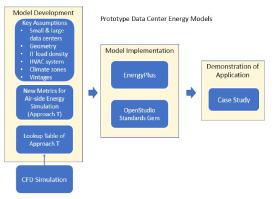当前位置:
X-MOL 学术
›
Energy Build.
›
论文详情
Our official English website, www.x-mol.net, welcomes your
feedback! (Note: you will need to create a separate account there.)
Prototype energy models for data centers
Energy and Buildings ( IF 6.6 ) Pub Date : 2020-11-05 , DOI: 10.1016/j.enbuild.2020.110603 Kaiyu Sun , Na Luo , Xuan Luo , Tianzhen Hong
Energy and Buildings ( IF 6.6 ) Pub Date : 2020-11-05 , DOI: 10.1016/j.enbuild.2020.110603 Kaiyu Sun , Na Luo , Xuan Luo , Tianzhen Hong

|
Data centers in the United States consume about twopercent of the nation’s electricity. Because heat gains from IT equipment drive cooling demand, data centers offer unique opportunities for energy savings. However, no prototype energy model for data centers is available in the suite of existing U.S. Department of Energy’s Commercial Prototype Building Models. This study presented the development of two new data center prototype models and their implementation in OpenStudio and EnergyPlus. The small-size data center model represents a computer room in a building served by computer room air conditioners (CRACs); while the large-sized model represents stand-alone data centers served by computer room air handlers (CRAHs) with a central chiller plant. For each data center model, two levels of IT equipment (ITE) load density were considered, to cover the wide range of IT power density of data centers: 40 and 100 W/ft (430 and 1076 W/m) for the computer room, and 100 and 500 W/ft (1076 and 5382 W/m) for the stand-alone data center. All other assumptions, such as building envelope, lighting, HVAC efficiencies and schedules, were based on the minimal requirements of ASHRAE Standard 90.1 at various vintages. We introduced a novel concept of supply and return air approach temperatures to capture the essential effects of non-uniform airflow and temperature distribution in data centers. The approach temperatures were pre-computed by computational fluid dynamics (CFD) simulations for various configurations of ITE loads and airflow containment management in data centers. A new feature was developed in EnergyPlus to implement the approach temperature method. A case study was conducted to demonstrate the use of the data center models. The two data center models cover all U.S. climate zones and can be used to evaluate energy saving measures for data centers, as well as to support development of data center energy efficiency codes and standards.
中文翻译:

数据中心能源模型原型
美国的数据中心消耗了全国约百分之二的电力。由于 IT 设备产生的热量推动了冷却需求,因此数据中心提供了独特的节能机会。然而,美国能源部现有的商业原型建筑模型套件中没有提供数据中心的原型能源模型。本研究介绍了两个新数据中心原型模型的开发及其在 OpenStudio 和 EnergyPlus 中的实施。小型数据中心模型代表由机房空调 (CRAC) 服务的建筑物中的机房;大型模型代表由机房空气处理器 (CRAH) 和中央冷水机组提供服务的独立数据中心。对于每个数据中心模型,考虑了两个级别的 IT 设备 (ITE) 负载密度,以涵盖数据中心的各种 IT 功率密度:机房为 40 和 100 W/ft(430 和 1076 W/m) ,以及独立数据中心的 100 和 500 W/ft(1076 和 5382 W/m)。所有其他假设,例如建筑围护结构、照明、HVAC 效率和时间表,均基于不同年份的 ASHRAE 标准 90.1 的最低要求。我们引入了送风和回风接近温度的新颖概念,以捕捉数据中心内不均匀气流和温度分布的基本影响。通过计算流体动力学 (CFD) 模拟,针对数据中心内的 ITE 负载和气流遏制管理的各种配置预先计算接近温度。 EnergyPlus 中开发了一项新功能来实施接近温度方法。进行了案例研究来演示数据中心模型的使用。这两种数据中心模式覆盖全美 气候区,可用于评估数据中心的节能措施,以及支持数据中心能效规范和标准的制定。
更新日期:2020-11-05
中文翻译:

数据中心能源模型原型
美国的数据中心消耗了全国约百分之二的电力。由于 IT 设备产生的热量推动了冷却需求,因此数据中心提供了独特的节能机会。然而,美国能源部现有的商业原型建筑模型套件中没有提供数据中心的原型能源模型。本研究介绍了两个新数据中心原型模型的开发及其在 OpenStudio 和 EnergyPlus 中的实施。小型数据中心模型代表由机房空调 (CRAC) 服务的建筑物中的机房;大型模型代表由机房空气处理器 (CRAH) 和中央冷水机组提供服务的独立数据中心。对于每个数据中心模型,考虑了两个级别的 IT 设备 (ITE) 负载密度,以涵盖数据中心的各种 IT 功率密度:机房为 40 和 100 W/ft(430 和 1076 W/m) ,以及独立数据中心的 100 和 500 W/ft(1076 和 5382 W/m)。所有其他假设,例如建筑围护结构、照明、HVAC 效率和时间表,均基于不同年份的 ASHRAE 标准 90.1 的最低要求。我们引入了送风和回风接近温度的新颖概念,以捕捉数据中心内不均匀气流和温度分布的基本影响。通过计算流体动力学 (CFD) 模拟,针对数据中心内的 ITE 负载和气流遏制管理的各种配置预先计算接近温度。 EnergyPlus 中开发了一项新功能来实施接近温度方法。进行了案例研究来演示数据中心模型的使用。这两种数据中心模式覆盖全美 气候区,可用于评估数据中心的节能措施,以及支持数据中心能效规范和标准的制定。











































 京公网安备 11010802027423号
京公网安备 11010802027423号